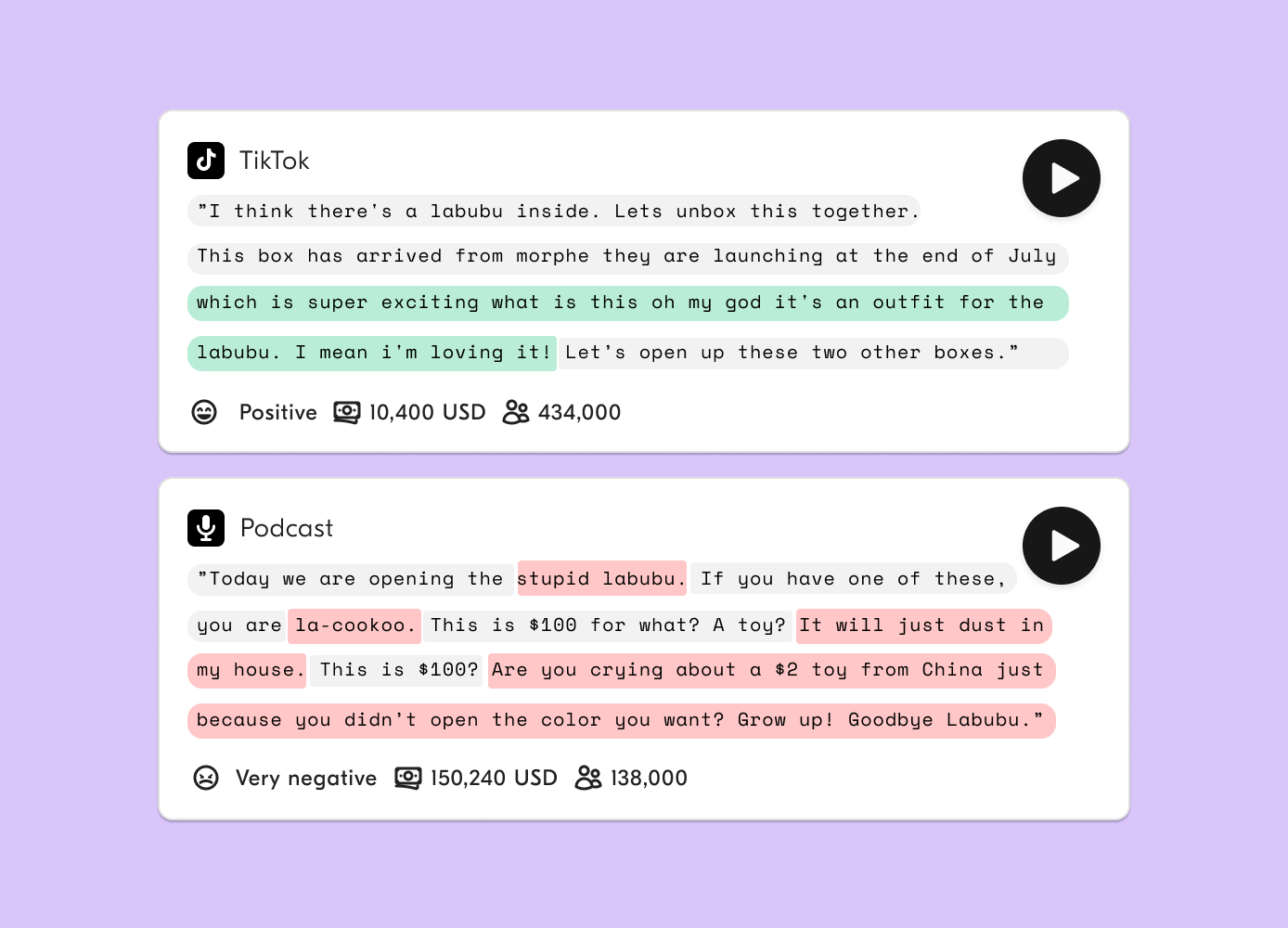Voice tone or mention volume? The real key to understanding brand sentiment
Social media is packed with opinions, from glowing praise to subtle complaints, and audiences share them openly on TikTok, YouTube, podcasts, reviews, and more. These conversations reveal far more than how often your brand is mentioned. The real insight comes from analyzing sentiment and understanding the tone behind.
A sarcastic remark on a podcast, or excitement in a TikTok review can influence brand perception and customer satisfaction far more than a hundred neutral mentions. These moments show that what is being said is only half the story and how it is said can be the difference between building trust and losing it.
Mention counts are a useful measure of brand visibility, but on their own they can be misleading. A spike in conversation could be driven by positive sentiment or by negative mentions quietly damaging trust. By analyzing sentiment in spoken media, brands can detect these shifts early, protect customer satisfaction, and act on opportunities that competitors miss.
The limitations of measuring only mentions
If you work in marketing, PR, or advertising, you know the value of tracking mentions, whether it is your campaign, a key buzzword, or your brand name. Most brands do this through Google Alerts, social listening tools, or media monitoring platforms. It is a smart starting point, as knowing how often your name appears means you are aware of your visibility.
But here is the problem, more mentions do not always mean more goodwill. A spike in activity could be driven just as easily by negative mentions as by positive sentiment. You might see a surge after a campaign launch and assume it is a win worth presenting to stakeholders, yet without knowing the tone behind those mentions, you could miss early signs of reputational risk. Negative sentiment can quietly spread, eroding customer satisfaction before you notice.
This is why analyzing sentiment is essential. It not only shows that people are talking but also reveals how they feel. Applying the same approach to your competitors can uncover powerful competitive intelligence, helping you spot perception gaps and opportunities to strengthen your position.
Why voice tone often is a more trustworthy signal
Written sentiment, like in tweets or reviews, can be analyzed at scale, but it is also easier to misread. Sarcasm can be lost without tone indicators, emojis can confuse sentiment models, and bots or fake accounts can inflate volume without adding genuine audience insight. Voice is different. It communicates emotion naturally:
Excitement, frustration, and confusion are easy to hear.
Tone of voice reveals the underlying sentiment behind words.
It is harder to fake or automate.
Audiences trust real human voices far more than anonymous text.
This is why voice tone often carries more weight than mention volume. A podcast host praising a product with genuine enthusiasm can drive more positive sentiment and customer satisfaction than a thousand identical five-star reviews.
Same words, completely different meaning
Picture this: You’re relaxing on the sofa, scrolling through TikTok. A video pops up, and the creator says:
“I have been using their product for a few weeks now.”
On paper, that sentence is neutral. But the way it’s spoken can change everything:
Boredom and a sigh → Feels negative, leaving the audience unimpressed and hurting customer satisfaction.
Surprise and energy → Feels positive, sparking trust and driving purchase intent.
Sarcasm → Sounds dismissive, turning the message into a negative impression despite neutral wording.
If you only read the text, you would likely miss the real meaning. Voice tone adds that missing layer of context, and analyzing sentiment in spoken media ensures you catch it. The audience’s reaction is shaped not just by the words, but by the emotion behind them.
Does voice tone matter more than mention volume?
The short answer is yes. Mention volume tells you how much people are talking, but voice tone tells you what those conversations actually mean. A thousand mentions without positive sentiment will not move your brand forward, but a handful of genuinely enthusiastic mentions can build trust, influence perception, and drive action. That is why, for brands serious about reputation and growth, voice tone is the signal to watch most closely.
Ready to discover what people are really saying about your brand on TikTok, podcasts, and YouTube? Book a demo below to see how AI-powered social listening can fuel your next big move and get a glimpse of you mentions in our platform.


